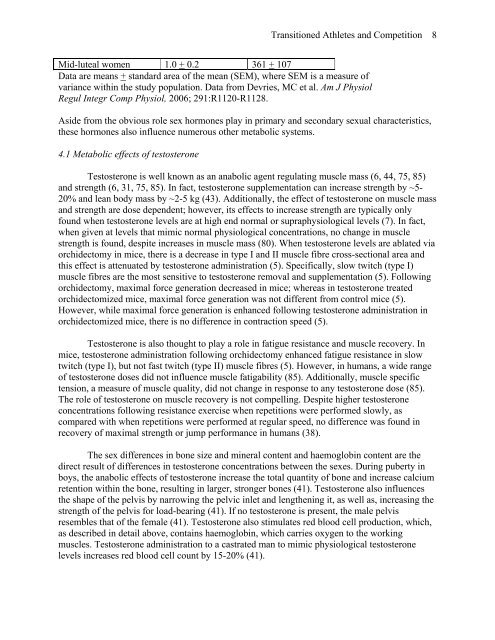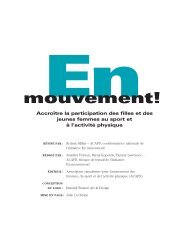Do Transitioned Athletes Compete at an Advantage or Disadvantage
Do Transitioned Athletes Compete at an Advantage or Disadvantage
Do Transitioned Athletes Compete at an Advantage or Disadvantage
You also want an ePaper? Increase the reach of your titles
YUMPU automatically turns print PDFs into web optimized ePapers that Google loves.
<strong>Tr<strong>an</strong>sitioned</strong> <strong>Athletes</strong> <strong>an</strong>d Competition 8<br />
Mid-luteal women 1.0 + 0.2 361 + 107<br />
D<strong>at</strong>a are me<strong>an</strong>s + st<strong>an</strong>dard area of the me<strong>an</strong> (SEM), where SEM is a measure of<br />
vari<strong>an</strong>ce within the study popul<strong>at</strong>ion. D<strong>at</strong>a from Devries, MC et al. Am J Physiol<br />
Regul Integr Comp Physiol, 2006; 291:R1120-R1128.<br />
Aside from the obvious role sex h<strong>or</strong>mones play in primary <strong>an</strong>d secondary sexual characteristics,<br />
these h<strong>or</strong>mones also influence numerous other metabolic systems.<br />
4.1 Metabolic effects of testosterone<br />
Testosterone is well known as <strong>an</strong> <strong>an</strong>abolic agent regul<strong>at</strong>ing muscle mass (6, 44, 75, 85)<br />
<strong>an</strong>d strength (6, 31, 75, 85). In fact, testosterone supplement<strong>at</strong>ion c<strong>an</strong> increase strength by ~5-<br />
20% <strong>an</strong>d le<strong>an</strong> body mass by ~2-5 kg (43). Additionally, the effect of testosterone on muscle mass<br />
<strong>an</strong>d strength are dose dependent; however, its effects to increase strength are typically only<br />
found when testosterone levels are <strong>at</strong> high end n<strong>or</strong>mal <strong>or</strong> supraphysiological levels (7). In fact,<br />
when given <strong>at</strong> levels th<strong>at</strong> mimic n<strong>or</strong>mal physiological concentr<strong>at</strong>ions, no ch<strong>an</strong>ge in muscle<br />
strength is found, despite increases in muscle mass (80). When testosterone levels are abl<strong>at</strong>ed via<br />
<strong>or</strong>chidectomy in mice, there is a decrease in type I <strong>an</strong>d II muscle fibre cross-sectional area <strong>an</strong>d<br />
this effect is <strong>at</strong>tenu<strong>at</strong>ed by testosterone administr<strong>at</strong>ion (5). Specifically, slow twitch (type I)<br />
muscle fibres are the most sensitive to testosterone removal <strong>an</strong>d supplement<strong>at</strong>ion (5). Following<br />
<strong>or</strong>chidectomy, maximal f<strong>or</strong>ce gener<strong>at</strong>ion decreased in mice; whereas in testosterone tre<strong>at</strong>ed<br />
<strong>or</strong>chidectomized mice, maximal f<strong>or</strong>ce gener<strong>at</strong>ion was not different from control mice (5).<br />
However, while maximal f<strong>or</strong>ce gener<strong>at</strong>ion is enh<strong>an</strong>ced following testosterone administr<strong>at</strong>ion in<br />
<strong>or</strong>chidectomized mice, there is no difference in contraction speed (5).<br />
Testosterone is also thought to play a role in f<strong>at</strong>igue resist<strong>an</strong>ce <strong>an</strong>d muscle recovery. In<br />
mice, testosterone administr<strong>at</strong>ion following <strong>or</strong>chidectomy enh<strong>an</strong>ced f<strong>at</strong>igue resist<strong>an</strong>ce in slow<br />
twitch (type I), but not fast twitch (type II) muscle fibres (5). However, in hum<strong>an</strong>s, a wide r<strong>an</strong>ge<br />
of testosterone doses did not influence muscle f<strong>at</strong>igability (85). Additionally, muscle specific<br />
tension, a measure of muscle quality, did not ch<strong>an</strong>ge in response to <strong>an</strong>y testosterone dose (85).<br />
The role of testosterone on muscle recovery is not compelling. Despite higher testosterone<br />
concentr<strong>at</strong>ions following resist<strong>an</strong>ce exercise when repetitions were perf<strong>or</strong>med slowly, as<br />
compared with when repetitions were perf<strong>or</strong>med <strong>at</strong> regular speed, no difference was found in<br />
recovery of maximal strength <strong>or</strong> jump perf<strong>or</strong>m<strong>an</strong>ce in hum<strong>an</strong>s (38).<br />
The sex differences in bone size <strong>an</strong>d mineral content <strong>an</strong>d haemoglobin content are the<br />
direct result of differences in testosterone concentr<strong>at</strong>ions between the sexes. During puberty in<br />
boys, the <strong>an</strong>abolic effects of testosterone increase the total qu<strong>an</strong>tity of bone <strong>an</strong>d increase calcium<br />
retention within the bone, resulting in larger, stronger bones (41). Testosterone also influences<br />
the shape of the pelvis by narrowing the pelvic inlet <strong>an</strong>d lengthening it, as well as, increasing the<br />
strength of the pelvis f<strong>or</strong> load-bearing (41). If no testosterone is present, the male pelvis<br />
resembles th<strong>at</strong> of the female (41). Testosterone also stimul<strong>at</strong>es red blood cell production, which,<br />
as described in detail above, contains haemoglobin, which carries oxygen to the w<strong>or</strong>king<br />
muscles. Testosterone administr<strong>at</strong>ion to a castr<strong>at</strong>ed m<strong>an</strong> to mimic physiological testosterone<br />
levels increases red blood cell count by 15-20% (41).






